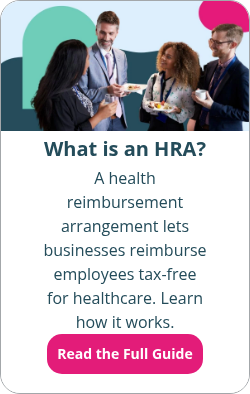Can I have an HRA and an FSA at the same time?
By Elizabeth Walker on July 21, 2025 at 3:00 PM
Does your employer offer you a health reimbursement arrangement (HRA)? if so, you have access to a flexible health benefit that empowers you to make your own healthcare choices. But, it’s essential to understand how an HRA works with other health benefits you may have, including a healthcare flexible spending account (FSA).
If you have a health FSA and an HRA, don’t worry—in most cases, you can still use both benefits. But there are special rules to remember as you coordinate the two health plans.
In this blog post, you’ll learn:
- How health reimbursement arrangements (HRAs) and flexible spending accounts (FSAs) work, including their benefits and key differences.
- How to coordinate these two benefits effectively, including rules for avoiding "double dipping" and maximizing tax savings.
- Which combinations of HRAs and FSAs are allowed, and the specific guidelines for each.
What is a health reimbursement arrangement (HRA)?
An HRA is a formal health benefit that allows employers to reimburse their employees tax-free for qualifying out-of-pocket medical expenses. Depending on the type of HRA, your employer can reimburse you for individual health insurance premiums, eligible out-of-pocket costs, or both.
An increasing number of employers are leveraging HRAs to allow their employees to purchase individual health policies instead of offering one group plan. Despite the name, individual health insurance can cover one individual or a family.
Here are some key takeaways about HRAs for employees:
- Your employer gives you a set monthly allowance to pay for medical expenses. By law, only employers can contribute to an HRA.
- Your employer creates plan documents outlining what you can use your HRA funds for. If you have a stand-alone HRA, this includes whether you can receive reimbursement only for health insurance premiums or for premiums plus other qualified expenses.
- You purchase any necessary healthcare items and services for you and your family. Then, you submit claim documentation proving you paid for the eligible medical service or item. Your employer reimburses you tax-free up to your allowance.
- Allowance amounts can roll over monthly. Depending on your HRA provider, annual rollover may also occur. But in contrast to health savings accounts (HSAs), HRA funds stay with your employer if they don’t roll over at the end of the year or if you leave their company.
- HRA reimbursements are income-tax-free for employees.
With an HRA, you have better control over your out-of-pocket healthcare costs and more flexibility and authority over your medical care.
The following are the three most popular types of HRAs:
- The individual coverage HRA (ICHRA). An ICHRA is offered as a standalone health benefit by employers of all sizes and has no maximum contribution limits. To participate in this benefit, you must have a qualifying form of individual health insurance.
- Suppose you already have individual coverage through the ACA Marketplace and receive premium tax credits. In that case, you’ll want to decide whether to opt in or out of this benefit, as the offer of an ICHRA can impact tax credit eligibility depending on affordability.
- The qualified small employer HRA (QSEHRA). A QSEHRA is for organizations with fewer than 50 full-time equivalent employees (FTEs). While it has maximum annual contribution limits, it has no minimum limits. All full-time W-2 employees are automatically eligible to participate in a QSEHRA, and employers can choose to make part-time employees eligible as well. In order to participate in this benefit, you need minimum essential coverage (MEC).
- The group coverage HRA (GCHRA), or integrated HRA. A GCHRA is for employers of all sizes who offer a traditional group health plan. With a GCHRA, you can receive tax-free reimbursement for out-of-pocket healthcare costs, like deductibles and coinsurance. But you can’t receive reimbursements for premiums. Like an ICHRA, GCHRAs have no maximum contribution limits. Only employees enrolled in their employer’s group plan can participate.
What is a flexible spending account (FSA)?
Next, let’s review FSAs. Flexible spending accounts, sometimes called flexible spending arrangements, are employer-owned savings accounts. With an FSA, employers and employees can contribute pre-tax funds toward future healthcare or dependent care expenses.
Here are some key takeaways about FSAs for employees:
- FSAs have annual maximum contribution limits. In 2026, you can contribute a maximum of $3,400 toward a healthcare FSA. If your spouse has a separate FSA under their employer, they can also receive contributions up to the cap.
- If your employers allow your previous year’s funds to carry over, the maximum carryover amount is $680.
- Employees can withdraw funds from their FSA with an FSA debit card or request reimbursement, even if they haven't contributed to the account yet.
- FSAs are dependent on employment. So you can’t keep the account or unused funds if you leave your job.
- In most cases, FSAs have a “use-it-or-lose-it” policy. Any unused funds at the plan year's end go back to your employer. The money you don’t spend by the end of the plan year won’t roll over.
To fully benefit from your FSA, it’s best to use all available money on the expenses you planned to use it on.
There are several types of FSAs:
- Health FSA: This FSA allows you to use pre-tax dollars for out-of-pocket expenses outlined in IRS Publication 5021. This includes doctor visit copays, prescriptions, deductibles, and other healthcare costs.
- Limited-purpose FSA: This type of FSA only covers qualified vision care and dental expenses. Because of these restrictions, it’s the only type of FSA that works alongside an HSA.
- Dependent care FSA: A dependent care FSA helps you pay for employment-related dependent care services on a pre-tax basis. A dependent is someone who can't take care of themselves, including children younger than 13 and adult dependents with physical or mental disabilities.
- Adoption FSA: With an adoption FSA, employees can set aside pre-tax money for expenses incurred while adopting a child.
- Commuter FSAs: These FSAs allow you to pay for employment-related commuter services with pre-tax money. The transit FSA and the parking FSA are available under this benefit category.
Many employees have access to a health FSA as part of their benefits package. For the rest of this article, we’ll discuss health FSAs specifically.
How do HRAs and FSAs compare?
Below is a quick comparison chart to further explain the differences between HRAs and healthcare FSAs.
|
Comparison point |
HRA |
Health FSA |
|
What is it? |
HRAs are employer-funded, tax-advantaged benefits. These flexible alternatives or supplements to group health insurance allow employers to reimburse employees tax-free for eligible medical expenses. Popular types include the QSEHRA, ICHRA, excepted benefit HRA (EBHRA), and GCHRA. |
FSAs are employer-established benefit plans that allow for tax-free reimbursement of qualified healthcare expenses. |
|
What are the eligibility requirements? |
Eligibility depends on the type of HRA your employer offers. QSEHRA: All W-2 full-time employees with a health plan that provides MEC can participate. Employers can also include part-time employees. ICHRA: Employees must have a qualified individual plan to participate. Employers can customize eligibility using job-based employee classes. GCHRA: All enrolled employees in the employer’s group health plan can participate. EBHRA: All employees offered a group plan, even if they don’t participate in it. Owner eligibility is dependent on your business type. |
All employees who aren’t self-employed can participate. |
|
Who owns the account/arrangement? |
An HRA is an employer-owned arrangement. |
An FSA is an employer-owned account. |
|
What is the average employer contribution cost? |
HRAs aren’t pre-funded benefits. Employers only reimburse employees once they submit proof of an eligible expense. In 2023, the average monthly contribution for employers offering a QSEHRA through PeopleKeep was $431. The average monthly ICHRA contribution for PeopleKeep and Remodel Health customers in 2024 was $524. |
Employers aren’t required to contribute to an FSA. But, if they choose to do so, employees can access their full annual contribution on day one, regardless of utilization. |
|
Who can contribute? |
Only the employer can contribute. |
The employee and employer can contribute. |
|
How much can you contribute each year? |
Employers determine their contribution amounts. However, the IRS limits the QSEHRA’s annual maximum allowance amounts. The 2026 employer annual contribution limit for QSEHRA is $6,450 per self-only coverage and $13,100 for family coverage. The ICHRA and GCHRA have no maximum contribution limits. |
The employer determines contribution amounts, But it can't exceed the IRS annual limit of $3,400 in 2026. |
|
Is the account/arrangement taxed? |
No, it’s payroll tax-free for the employer and income tax-free for employees. |
No, it’s tax-free. |
|
Is a health insurance plan required? |
Depending on the type of HRA, a health plan may be necessary to participate in the benefit QSEHRA: Employees must have a health plan that meets MEC. ICHRA: Employees must have a qualifying form of individual health insurance. GCHRA: Employees must have coverage from their employer-sponsored group health plan. |
It depends. A limited-purpose FSA is an excepted benefit and doesn’t require an employee to buy insurance. A health FSA must accompany group insurance to comply with the Affordable Care Act (ACA) market reforms. Only organizations with 50 or more FTEs are subject to the ACA employer mandate. |
|
Which qualified health expenses are eligible? |
All unreimbursed medical care expenses outlined in IRC 213(d), including individual health insurance premiums. IRS Publication 502 has the complete list of eligible items and medical services. |
All unreimbursed medical care expenses outlined in IRC 213(d)3. However, you can’t use an FSA to pay for insurance premiums4. |
|
Do funds carry over to the next year? |
Unused funds automatically roll over monthly. However, the type of HRA and how the employer designs the benefit determine whether yearly rollovers are allowed. |
Yes, if determined by the employer. The IRS allows annual rollovers up to $680 in 2026. |
|
Who administers the account/arrangement? |
The employer, third-party administrator (TPA), or HRA software solution provider. |
The employer or a third-party administrator (TPA). |
|
Is the account/arrangement portable after the termination of employment? |
No. Unused HRA funds stay with the employer once an employee leaves the organization. Employees don’t lose access to their individual health insurance plans if they have a QSEHRA or ICHRA. |
No. The employee loses access to the account if they stop working for the employer. |
How do HRAs and FSAs work together?
If your employer offers you both an HRA and an FSA—great! Using both is an excellent way to maximize employer contributions to your healthcare, optimize your tax savings, and save even more on out-of-pocket expenses. However, an FSA only works alongside certain types of HRAs.
Can you use an ICHRA and an FSA together?
Yes, you can use an ICHRA and a medical FSA together. But you’ll need to follow some special rules to coordinate the two.
Here’s how you can use an ICHRA and an FSA together:
- Since they both have tax advantages, you can’t request reimbursement for the same eligible expense from your HRA and FSA. This process is called “double dipping.” IRS Publication 969 requires a written statement for health FSAs stating you didn’t pay for the expense under any other health coverage, including HRAs5.
- Some situations may allow reimbursement from multiple accounts. For example, if you have a $600 medical bill but only have $300 in HRA funds left available, you may claim the remaining $300 from your FSA.
- Unless otherwise specified in your plan documents, you must use your total HRA allowance before using your healthcare FSA funds. However, your employer can change your plan documents to allow you to use your FSA funds first for medical expenses.
Do QSEHRAs and FSAs work together?
No, you can’t use an FSA with a QSEHRA. Section 9831 of U.S. Code Title 26 only allows employers to offer a QSEHRA if they don’t offer a group health plan to any of their employees6. This includes other HRAs, medical FSAs, and limited-purpose FSAs for vision and dental expenses.
If you’re using your spouse’s FSA and not one your employer offers, you can coordinate it with your QSEHRA. To stay compliant, follow your specific plan documents and the rules mentioned in the previous ICHRA section.
Can you use a GCHRA and an FSA together?
Yes, you can coordinate an integrated HRA with an FSA. As with an ICHRA, your employer must design your plan documents to clearly state whether you should use your FSA or GCHRA first. You’ll also need to avoid “double dipping.”
Conclusion
Using an HRA and an FSA together is a smart way to take advantage of employer-sponsored health benefit plans. They allow you to access more tax-free money for the qualifying medical expenses you incur for yourself, your spouse, and your dependents.
While an FSA doesn’t work alongside a QSEHRA, you can use one with an ICHRA or GCHRA. By following the guidelines for FSA coordination, you’ll be ready to use both perks in your benefits package like a pro!
This article was originally published on August 16, 2021. It was last updated on July 21, 2025.
Check out more resources
See these related articles

HRAs and W-2 annual reporting
Learn about HRA W-2 annual reporting requirements. Understand what employers need to include on employees' W-2 forms for HRA compliance.

What employers need to know about HRA debit cards
Are you considering HRA debit cards for your workers? Find out why they may not be the best option for your company and what alternatives you can explore.

Does an HRA work with Medicaid?
Find out if an HRA can be used with Medicaid. Learn how HRA reimbursements work for employees enrolled in Medicaid and what limitations may apply.



